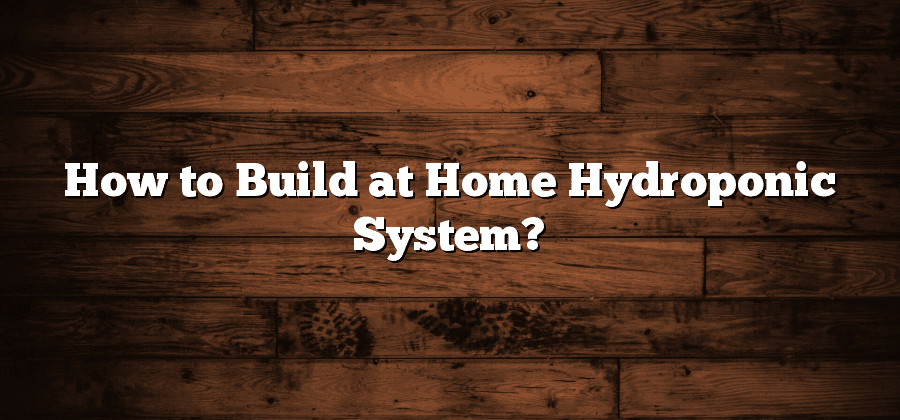Components needed for a DIY hydroponic system
To set up a successful DIY hydroponic system, there are a few key components that you will need. Firstly, you will require a reservoir to hold the nutrient solution. This can be anything from a plastic container to a specially designed tank. Ensure that the reservoir has a lid or cover to prevent evaporation and to maintain the integrity of the nutrient solution.
Next, you will need a grow tray or container to hold your plants and the growing medium. This can be a shallow tray, a series of trays, or even a vertical tower system. The choice of grow tray will depend on the type and size of plants you wish to grow, as well as the available space. It is important to select a grow tray that is sturdy enough to hold the weight of the plants and the growing medium, while also allowing for proper drainage and aeration.
Selecting the right location for your hydroponic system
When it comes to selecting the right location for your hydroponic system, there are a few key factors to consider. Firstly, adequate sunlight is crucial for the success of your plants. Ideally, you want to find a location that receives at least six to eight hours of direct sunlight each day. This will ensure that your plants receive the necessary amount of light for photosynthesis and healthy growth.
In addition to sunlight, you should also take into account the temperature and humidity levels of the chosen location. Most hydroponic plants thrive in temperatures ranging between 70 to 80 degrees Fahrenheit. Avoid areas that are prone to extreme temperature fluctuations, as this can negatively impact the plants’ growth and overall health.
Furthermore, it is essential to choose a location where the hydroponic system can be easily accessed for maintenance and monitoring. This will make it convenient for you to adjust nutrient levels, pH balance, and inspect for any pest or disease issues. Additionally, selecting a location near a water source will make it more convenient when it comes to topping up the reservoir or adding nutrients to the system.
Consider these factors carefully before deciding on the location for your hydroponic system. By selecting the right spot, you will provide your plants with the optimal conditions for growth and ensure the overall success of your hydroponic project.
Choosing the appropriate hydroponic system design
When it comes to choosing the appropriate hydroponic system design, there are several factors to consider. One of the first things to think about is the space available for your hydroponic setup. If you have a limited area, you may want to opt for a vertical system that maximizes the use of vertical space. On the other hand, if you have a larger area, you might have the flexibility to choose a horizontal system that allows for more plant growth.
Another important consideration is the type of plants you plan to grow. Different plants have different growth habits and nutritional needs. For example, leafy greens like lettuce or spinach thrive in nutrient film technique (NFT) systems, while larger fruiting plants like tomatoes or peppers may require a deep water culture (DWC) system. It’s crucial to do your research and choose a hydroponic system design that is suitable for the specific plants you intend to cultivate.
Building the reservoir and nutrient solution
When it comes to building a DIY hydroponic system, constructing the reservoir and preparing the nutrient solution are crucial steps that require careful attention. The reservoir serves as a container for holding the nutrient solution, which is the essential element for the plants to grow and thrive in a soil-less environment. To ensure the success of your hydroponic setup, it is important to consider a few key factors before building the reservoir.
Firstly, the size of the reservoir must be determined based on the number of plants you plan to grow. It is advisable to choose a larger container to prevent the nutrient solution from running out too quickly, which could lead to dehydration of the plants. Additionally, the reservoir should be made of sturdy, non-toxic materials that are resistant to corrosion and can withstand the weight of the nutrient solution. This will help maintain the integrity of the system and prevent any potential leaks or contamination.
Constructing the grow tray for your hydroponic system
To begin constructing the grow tray for your hydroponic system, you will first need to gather the necessary materials. The grow tray serves as the base where your plants will be placed and is crucial for their growth and development. You will need a sturdy and waterproof material such as plastic or metal that can withstand the moisture levels required for hydroponic gardening.
Once you have the appropriate material, carefully measure and cut it to the desired size for your grow tray. It is important to ensure that the tray fits snugly within your hydroponic system and can hold the weight of the plants and the nutrient solution. Take into consideration the number of plants you plan to grow and the space available for them to thrive. Additionally, drilling small holes at regular intervals on the bottom of the tray will allow for proper drainage and prevent waterlogging, which can lead to root rot.






